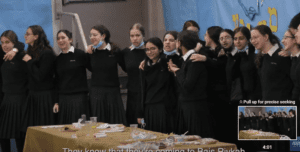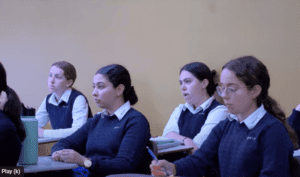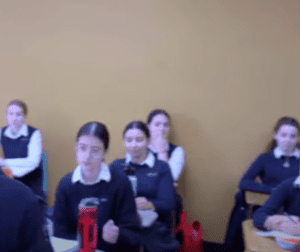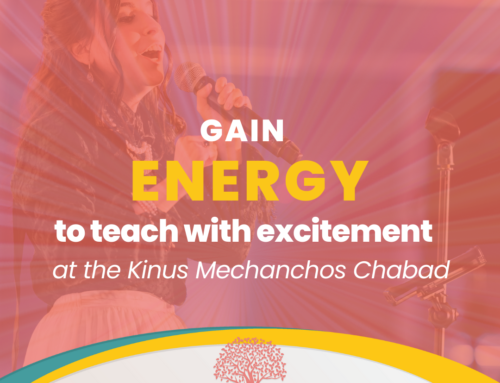“Meet the Chinuch Shluchim” is a series that features Chabad teachers from different states, countries and demographics speaking about their life and Chinuch Shlichus.
This week: Bais Rivkah High School Teacher, Ms. Miriam Elberg, on making Chassidus practical for high school girls, opening a traveling camp during Covid, and what today’s teenagers need to hear most.
Your role:
I teach Chassidus to tenth and twelfth grade at Bais Rivkah High School. In tenth grade I teach Tanya Perakim Zayin through Tes Zayin. In twelfth grade I teach Maamarim including Beyom Ashtei Asar, Usfartem Lachem, Heichaltzu, Lehavin Inyan Simchas Torah, and Basi Legani (5711).
Becoming a teacher:
When I got to seminary in Yerushalayim, I developed an appreciation for learning Chassidus. As a student at Bais Rivkah High School I didn’t feel like I owned what I learned, or deeply understood the concepts. In seminary, the teachers made it their business to point out how much we still didn’t know, and they inspired me to recognize that I need to be learning if I want to be in line with Emes. It was a really big shift.
Afterwards I went to Mayanot as a Shlucha, where we were trained how to properly learn Maamarim and Torah Ohr from the text. My appreciation for learning grew even more. I had never thought of becoming a teacher or that it was something I could do. When I was in school, the teachers seemed to have a difficult time since not many girls seemed interested in learning, but I didn’t want high school girls to have to wait until seminary to appreciate learning like I did. From Mayanot I applied to work at Bnos Menachem, where I taught Tanya and Inyanei Geulah U’Moshiach for a year, and then continued on to Bais Rivkah where I’ve been since.
Your students:
I have about 115 students. By the time they enter my class mid-high school, they have the young child’s view that there is a Hashem, and that they have a Father. They know they are here to make a Dira Betachtonim, and they know the right terminology, but they don’t necessarily know what it really means, and are not always open to it. My job as the teacher is to open them up to gaining a deeper understanding of what it means to be a Yid. I show that Chabad Chassidus lets them get to know Hashem and understand what it means to serve Him.
What do today’s teenagers need to hear most?
Many high school students are often faced with a lot of social pressure and self doubt.
I am passionate about teaching Perek Mem Alef Tanya. It points out that “Vehinei Hashem nitzav alav”- that Hashem cares about you and watches over you, and that shows how important you are. That recognition is the foundation of a Yid.
While reading the book “Healthy in Mind, Body and Spirit,” I noticed that the Rebbe often responded to people who wrote that they had self-doubts or felt down to learn Perek Mem Alef Tanya. I want my students to realize that learning this Perek is an answer to them in their personal lives too.
Your methodology for teaching Chassidus:
To open them up to new concepts, I try to come up with ways to ask questions from different angles. For example, I will first explain what a Beinoni is before mentioning the word “Beinoni.” This way they could fit the real meaning of it with the word for a deeper understanding of what it means. won’t mention the word “Beinoni” until they understand what it means.
We have a lot of class discussions too. I show my students how Chassidus is practical to our lives, since it changes the way we think, how we view Hashem, the world and ourselves.
When they give answers I try to push them to go deeper. It’s hard, but learning is a process. I see a difference from the beginning and end of the year. I want my students to realize there is so much more to know, and walk away feeling the desire to learn more.
Your thoughts on women’s learning:
The Alter Rebbe, in his Shulchan Aruch, wrote that women need to learn the Halachos that pertain to their daily lives. Included in that are the six constant Mitzvos, like “Emunah, Achdus Hashem, Yirah and Ahavas Hashem.” The way to fulfill those Mitzvos is through learning Chassidus. The Rebbe spoke about this while handing out Tanyas to women. Our learning is a must. We should be taught how to learn and have the ability to do so.
Bringing the concepts beyond the classroom:
I convey that what we learn is not a subject, it’s a life, and has to translate to Avodah. We make farbrengens after finishing a Maamar or Perek Tanya. We talk about what we learned, and think of ways for it to lead to real change in our personal lives.
Building the emotional connection:
It’s not just about learning ideas, but building connections. A real Mechanech’s role is to give Hashpa’ah through connection. I have small conversations with students in the hallway before class, during farbrengens and shabbatons, and school events. I wish there were more opportunities. I feel it is most important to form a connection with students.
Your summers spent with students:
After Covid my teacher friends and I decided we needed to do something for our students with no summer camp options. We did a camping trip for our students, which turned out to be an amazing experience for both the campers and us teachers. We went to Colorado, Arizona, and Utah. We called it “Expedition,” with the X designed to look like an Alef. The concept was to find the Alef – to find Hashem in everything and everywhere, and to bring the Alef of Geulah into Golah. There were 26 girls. They got to see how exploring the world isn’t a contradiction to serving Hashem, and how there are so many lessons in serving Hashem from seeing the world around us. We learned every morning and farbrenged every evening at the campsite. They felt more open to learning in the relaxed environment.
Do you ever get a vacation?
There isn’t much time for breaks or trips in my year, but in my time outside of school I enjoy learning, and try to learn about each Yom Tov as it approaches. I enjoy nature, go on hikes and when I’m able to I travel with friends.
A teaching challenge:
I have to teach my students that learning isn’t only about the test, but that our minds should be filled with knowledge of Hashem. I need to teach them to think critically, and not let the information just pass through the paper.
Your motivation:
My students are my motivation, when I see them have an “aha” moment, begin understanding things on a deeper level, or gain inspiration to learn on their own. Farbrenging with fellow teachers and friends heltps too.
A classroom “Aha” moment:
This week I was teaching the concept of Hashem being the only existence, that He was, is and will always be. A student asked why Hashem seems so selfish. I said that Hashem is actually the only self, the only existence. Everyone stopped what they were doing, and looked up in surprise. I told them that physically comes and goes, only Hashem is true. The only reason we are here is Hashem. I tried to show the difference between something being real or fake. People could make tons of money, but go bankrupt in a moment. Someone could gain a ton of influence on the media, but someone could create a rumor about them, and they lose it all. Hashem is the only real power, even though to us that isn’t always how it seems. To us the world seems to be real. The girls all looked shocked.
Best teaching tool:
I feel that the actual text of the Maamar or Perek of Tanya is where it’s at. I want to give my students an appreciation for learning inside the text, and the ability to be able to learn on their own. Technology doesn’t always enhance, and I don’t necessarily need it to bring ideas across in my lessons.
Role models:
The teachers I work with are special people. Just being around them and seeing how they are given over to Chinuch is an inspiration. I learn something from each one of them. It reminds me how needed it is to have teachers who really care.
What you wish you were told before you began teaching:
Sometimes you try to be like another good teacher, but at the end of the day you have to bring yourself to the classroom. You have to be you. It’s the most effective way to connect with your students.
Message for new teachers:
It’s not easy but you definitely see results and have nachas moments that are irreplaceable. I gain the most from hearing my students gain understanding and appreciation for what they’ve learned. You see the fruits of your labor and you gain even more. I find that I’m the luckiest person.
Condensed and edited for clarity.







